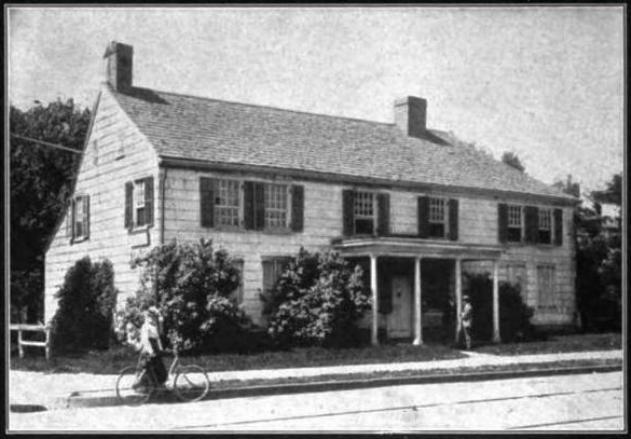 The old Bergen homestead at 972 Flatbush Avenue was originally the home of Dominie Bernadus Freeman, who served as pastor of the Reformed Dutch Church in Flatbush, Brooklyn, from 1705 to 1741. Photo from The Book of a Hundred Houses
The old Bergen homestead at 972 Flatbush Avenue was originally the home of Dominie Bernadus Freeman, who served as pastor of the Reformed Dutch Church in Flatbush, Brooklyn, from 1705 to 1741. Photo from The Book of a Hundred Houses
Built sometime around 1735, when Flatbush Avenue was still called Main Street, the John C. Bergen homestead — sometimes called the Freeman homestead — was the oldest house standing in the Flatbush neighborhood of Brooklyn when the photo above was taken just prior to 1901. Here’s a description of the home from The Book of a Hundred Houses, published in 1902:
The oldest house in Flatbush is the Bergen homestead, built by Dominie Freeman, who was mainly responsible for the spiritual welfare of early Flatbushers. This is a dwelling generous in its proportions, and unlike most its contemporaries, faces full upon the main thoroughfare. The original side shingles remain intact, but modern window-blinds have been substituted on the second floor for the heavy wooden shutters…
A simple porch supported by four plain columns, and a still more simpler door, with brass knocker and long panels, attract the attention of the most unlearned wayfarer. Many generations of Bergens have stepped out into the world from this same plain door that stares at the passing trolley-cars, and more than one romance has woven its magic charm around the long, substantial pile.
According to an article in the Brooklyn Daily Eagle (January 20, 1901), the home featured low ceilings with heavy wooden crossbeams, and the foundation and fireplace were constructed of bricks reportedly brought over from Holland. The front door opened to a long hall with a square sitting room to the right and a dining and living room to the left.
During the Battle of Long Island in August 1776, Dominie Freeman reportedly hid his vast collection of expensive wine in the eaves of the house, and then took to the woods with his only child, Anna Margaretta, and his son-in-law, David Clarkson. British soldiers discovered the wine and for three days took part in a drunken revelry. By the end of the party, the Red Coats had all but passed out under the trees in the yard.
David Clarkson and his bride moved into the homestead during the Revolution, and sometime after the war ended, the home and farm came into the possession of Hendrik Suydam, who in turn willed the property to his daughter Gertrude.
 In this 1890 E. Robinson map, the J.C. Bergen homestead is at the corner of Flatbush Avenue and Avenue A (renamed Albemarle Road in 1897). Butler Road: renamed Albemarle Road in 1904; Grant Street: renamed Snyder Avenue in 1903 for John Jacob Snyder, a prominent merchant in Flatbush. Map via New York Public Library Digital Collections.
In this 1890 E. Robinson map, the J.C. Bergen homestead is at the corner of Flatbush Avenue and Avenue A (renamed Albemarle Road in 1897). Butler Road: renamed Albemarle Road in 1904; Grant Street: renamed Snyder Avenue in 1903 for John Jacob Snyder, a prominent merchant in Flatbush. Map via New York Public Library Digital Collections.
In 1785, Gertrude Suydam married Cornelius Bergen, the son of Hans (Johannes) Bergen of Norway and the Sheriff of Kings County (1794 to 1805). John C. Bergen inherited the home and large farm from his parents as per Gertrude’s will dated April 25, 1838. John and his wife, Belinda Antonide, had several children — Cornelia Lozier Bergen, Mrs. Abraham Lott (Gertrude), and Mrs. William H. Story (Maria) — who continued to own and lease the house until 1901.
 Built in 1906, the brick structures at 962 to 972 Flatbush Avenue stand on what was once the old John C. Bergen homestead.
Built in 1906, the brick structures at 962 to 972 Flatbush Avenue stand on what was once the old John C. Bergen homestead.
On January 19, 1901, workmen began tearing down the Bergen homestead. Fortunately, the family was able to salvage a cannonball that had become implanted in the walls during the Battle of Long Island, and a window on which were engraved several names of patriots who fought in the Revolution.
The lot stood empty until 1905, when Prospect Park South, a 50-acre tract, was developed on part of the old Bergen farm. A year later, in 1906, the Abels-Gold Realty Company constructed six brick structures on the property fronting Flatbush Avenue, each with stores on the lower levels and apartments above.
For an interesting tour of Flatbush architecture, check out The Courts of Flatbush: 6 Cul-de-Sac Streets of Pre-War Brooklyn. Get in touch with the author at @HatchingCatNYC





